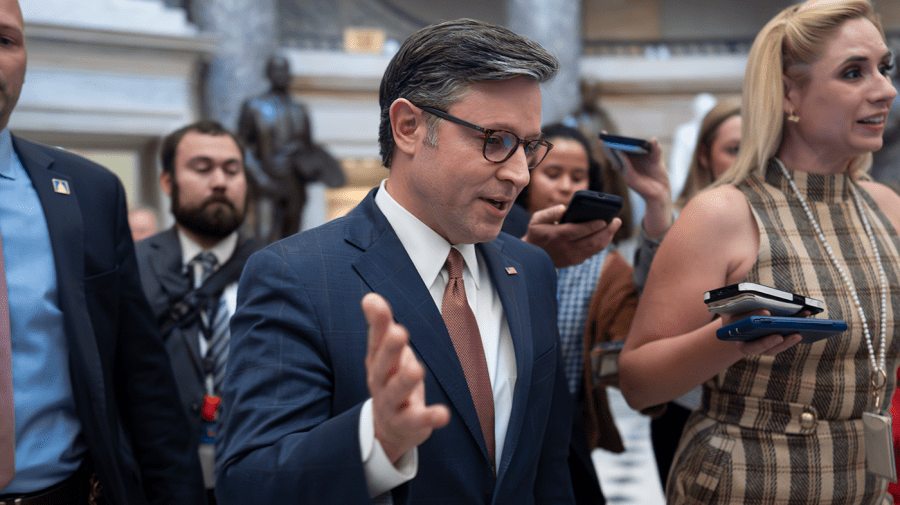As Congress enters a critical stretch to the November elections, a lengthy to-do list of critical funding items is piling in its absence.
Congressional leaders have faced pressure from all sides to return early in recent weeks to approve additional disaster aid in the wake of back-to-back hurricanes. While there hasn’t been any appetite to pull members off the campaign trail, the storms only add to a jam-packed agenda that awaits lawmakers when they return.
Here are some of the major items on that list so far.
Disaster loans
The Small Business Administration’s disaster loan program has exhausted its funds after weeks of warnings by administration officials.
President Biden, who announced the news Tuesday, said Speaker Mike Johnson (R-La.) vowed the program’s funds will be replenished after Congress returns from recess as scheduled next month.
“Speaker Johnson has promised that this and other disaster programs will be replenished when Congress returns, so Americans should continue to apply for these loans. SBA will continue to process applications and will disburse loans as soon as Congress provides the needed funding,” Biden said at the time.
Johnson also said at the time that Congress is “tracking this situation closely” and expects to have “an accurate assessment of the actual dollar amount needed” from the Biden administration on the necessary funding.
However, some GOP senators are pressing for more information on the program’s funds, while raising concerns about the agency’s handling of the program.
The SBA said this week that it “first raised the need for additional funds” to congressional funding chiefs last year and has since made multiple requests. Officials say they need about $1.6 billion for the agency’s program.
FEMA
Congressional leadership has also faced calls from members on both sides of the aisle in recent weeks to return early from recess to pass more funding for the Federal Emergency Management Agency’s (FEMA) disaster relief fund.
Congress last month passed a temporary stopgap measure to keep federal funding from lapsing in October and to prevent a government shutdown.
Negotiators said then that the deal allowed for the agency to use the fund’s fiscal 2025 resources faster for disaster response for the duration of the nearly three-month stopgap, letting FEMA draw from a roughly $20 billion pot starting Oct. 1.
While FEMA officials have said in recent weeks that it has sufficient resources to respond to hurricanes Milton and Helene while Congress is out of session in the short term, they also indicated to reporters a large chunk of that money is already gone.
Republicans and Democrats have introduced bills in the aftermath of hurricanes Helene and Milton for further disaster aid, including a $15 billion proposal offered by Rep. Jared Moskowitz (D-Fla.) and a $20 billion pitch from Sen. Marco Rubio (R-Fla.) and others.
Veterans Affairs
Congress passed an emergency spending bill before leaving last month that provides billions of dollars in funding for the Department of Veterans Affairs (VA) because officials warned benefit payments for veterans were at risk of being disrupted earlier this month absent congressional action.
However, the VA has also warned of a potential shortfall in fiscal 2025 and has asked Congress for roughly $12 billion in additional funding for medical care.
The agency has pointed to the PACT Act, a landmark law that passed with bipartisan support in 2022, as a key driver behind its finance woes, pointing to increases in enrollment in VA health care, appointments and applications benefits.
But lawmakers have been pressing for more information on the VA’s management of its budget and the events leading up to its initial shortfall.
As senators considered legislation to address the smaller, more immediate funding threat, Sen. Rand Paul (R-Ky.) unsuccessfully pushed for an amendment aimed at offsetting the costs of the bill, while citing the nation’s $35 trillion-plus debt.
At the time, he called the VA shortfall “foreseeable” after Congress expanded benefits years ago, while adding, “I think it is the priority and it is [the] responsibility of America to take care of its veterans, but we still have to think about what we’re doing.”
Overall funding
While the latest stopgap passed by Congress will keep the government open through mid-December, lawmakers are a ways away from finishing up their annual funding work.
The stopgap funding bill runs out on Dec. 20, and Speaker Mike Johnson (R-La.) has vowed to break precedent and not jam through one large omnibus funding measure before the holidays.
The coming presidential election could play a major role in what Congress does.
Conservatives bullish of former President Trump’s chances of winning back the White House had been pushing for Congress to punt the next funding deadline into early 2025. Proponents of the strategy say it would allow Trump more input over government funding, while also decreasing the likelihood of Congress squeezing through another massive, end-of-year omnibus funding package.
However, many Republicans are pushing for Congress to finish its funding work in December.
Sen. Susan Collins (Maine), top Republican on the Senate Appropriations Committee, said last month that it’s a “mistake” to pass a stopgap that “goes beyond December because regardless of who wins the presidential election, we should be presenting them with a clean slate.”
“They should not have the burden of dealing with issues of a fiscal year that began in October.”
